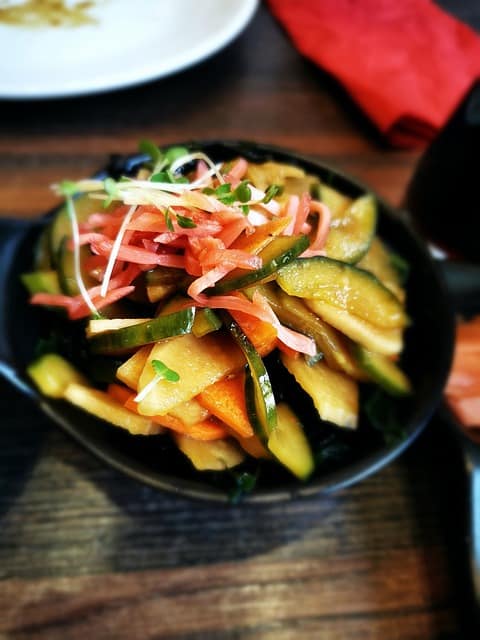It’s not just radish, every pickled vegetable out there either sold in grocery stores or processed at home does have an expiry date after which the contents should no longer be consumed.
This article explores how long pickled radishes last, what the telltale signs are to indicate a pickled radish that has gone bad, and what should be done with pickled radish that has gone bad.

When will a pickled radish go bad?
Pickled radish just like any other radish can go bad after storing for a while.
If you have one of those store-bought pickled radishes, then they would only keep in the refrigerator for a couple of months, provided they are kept intact in their packaging.
Homemade canned radishes however, will keep for a year + on the counter or even more in the refrigerator.
Pickled radishes would begin to diminish in quality the moment you open them and will only last a couple of weeks before they begin to show the signs of spoilage.
How can you tell if pickled radishes are bad?
There are quite a few signs that indicate spoilage in pickled radishes.
Mold growth
By far, one of the most obvious ways to know if your pickled radishes have gone bad is the presence of moldy growth on the surface of the brine.
Mold growth appears in different colors from brown, black, red, white, purple to even a combination of colors, but they all have a fuzzy appearance just like cotton ball.
Some people are of the opinion that so long as the pickles that are underneath the surface of mold are free from any signs of spoilage, they are perfectly safe to consume.
But then again, mold occurs in different species and varieties, and some of them are known to produce mycotoxins which can be very deadly when consumed.
In order to take off the guesswork of what kind of mold you have growing on your pickles, it’s best to discard both the containers and pickles inside them.
Smell
Now smell can also be another indication of a spoiled pickled radish although it is not a foolproof method since pickled radish themselves do emit some stench which most people associate with fart, old gym socks, or decomposing cabbage.
The last is not quite off because radishes belong to the Brassicaceae family which includes mustard and cabbage.
The key to identifying a spoiled cabbage via smell is to know how fermented or pickled radishes smell in the first place – which is sulfuric, and then tell it apart from the smell of spoilage, which is typically much more offensive.
Off color
Almost all pickles will undergo a change in coloration during their time under the brine, but if you notice something a bit different with your radishes, or maybe a completely different color on them, it may be a sign that they are decomposing or have something going on on them.
Taste
Another way to tell if a pickled radish has gone bad is from the way it tastes. No one is asking you to go and taste a radish that you suspect might be bad.
But if by accident, you happen to eat a radish and it tastes completely off, then it is the case that it has gone bad and you should discard the rest of the radish.
One quick thing must be said about cloudiness when pickling radishes.
Cloudiness does not necessarily indicate spoilage especially when you’re fermenting pickles. It is normal for the brine to turn cloudy which indicates the activities of the fermentation bacteria.
Will eating spoiled pickled radish make you sick?
There are chances that eating a spoiled pickled radish would make you sick, and terribly sick for that matter. Because of that, it is better to simply steer clear of eating spoiled radishes and go get a new one from the stores or prepare one yourself.
What caused my pickled radishes to go bad?
There are a number of reasons that cause pickled radishes to go bad. Sometimes it’s just as straightforward as aging, and sometimes it’s much more complicated than that.
The following are some of the reasons why your pickled radishes went bad.
Not following a standard recipe
This is by far the biggest cause for quick spoilage in pickles. Recipes, especially pickling recipes are out there for a reason, to show you exactly how to prepare pickles in the safest way possible.
Deviating from a standard recipe and chipping in your own contributions, would not only make the radishes unhealthy, but will also increase the chances of spoilage.
Using hands to remove pickles
And then comes the second reason which is using your hand to remove pickles from the jars.
It is usually a good practice to use clean utensils to remove pickles whenever you need to eat them and not your hands, because your hands contain bacteria that can be introduced into the medium which would cause quick spoilage.
Storing opened jars of pickles on the counter
Pickles can be left on the counter to ferment, but the moment they are canned and then opened later, they must be stored in the refrigerator.
Failure to do so means that you risk introducing bacteria into the medium whenever you open the jars, and because the room temperature is very suitable for the growth of bacteria, they would settle and begin to feast on the nutrients of the brine.
Aside from that, there are also chances of introducing pathogenic bacteria which will not cause spoilage of the pickles but will make you sick when you consume them.
Started out with bad radishes
One of the things that might have caused your radishes to go bad is the fact that you started off with a radish that was not in the greatest shape ever.
Fresh radishes are supposed to be firm to the touch and not soft or soggy. They should also not have visible injuries or visible signs of decay. You should also not smell anything funny on them and they should look plump with bright colors.
You should also make sure you’re washing the radishes very well to remove contaminants that can persist into the pickling medium and cause quick spoilage.
Using a brine from store bought radish to pickle the radishes
One big reason for a spoiled pickled radish too is using a store-bought brine for the pickling.
The brine must have already lost its pickling power through pickling radishes before. So using it now means you won’t get the appropriate strength or potency to tackle bacterial growth, and as a result, they will breed and eventually make their presence known in the pickles.

